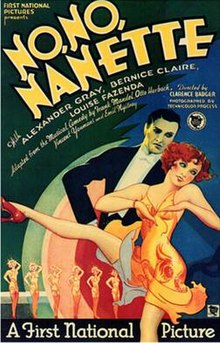| No, No, Nanette | |
|---|---|
 theatrical release poster | |
| Directed by | Clarence G. Badger |
| Written by | Howard Emmett Rogers (adaptation) Beatrice Van (dialogue) |
| Based on |
No, No, Nanette (1925 stage musical) by Otto A. Harbach Frank Mandel |
| Produced by | Ned Marin |
| Starring | Alexander Gray Bernice Claire Louise Fazenda |
| Cinematography | Sol Polito ( Technicolor) |
| Music by | (see Songs below) |
Production company | |
| Distributed by | First National Pictures |
Release dates |
|
Running time | 98 minutes |
| Country | United States |
| Language | English |
| Budget | $418,000 [2] |
| Box office | $1,451,000 [2] |
No, No, Nanette is a 1930 American pre-Code musical comedy film with Technicolor sequences that was directed by Clarence G. Badger and released by First National Pictures. [3] It was adapted from the play of the same title by Otto A. Harbach and Frank Mandel. No, No, Nanette was a popular show on Broadway, running for 321 performances, and was produced and directed by Harry Frazee. [4]

Plot
Jim Smith, a millionaire due to his Bible publishing business, is married to the overly frugal Sue. They desire to teach their ward Nanette to be a respectable young lady; she, in turn, has an untapped wild side. Nanette wants to have some fun in Atlantic City, while she is being pursued by Tom Trainor.
With so much unspent income at his disposal, Jim decides to become the benefactor for three beautiful women, but soon realizes his good intentions are bound to get him in trouble. He enlists his lawyer friend Bill to help him discreetly ease the girls out of his life. Sue and Billy's wife, Lucille, learn about the women and assume their husbands are having affairs with them.
Eventually, Bill and Jim explain the situation and are forgiven by their wives. Likewise, Nanette and Tom sort out their difficulties and decide to get married.
Cast
- Bernice Claire as Nanette
- Alexander Gray as Tom Trainor
- Lucien Littlefield as Jim Smith
- Louise Fazenda as Sue Smith
- Lilyan Tashman as Lucille
- Bert Roach as Bill Early
- ZaSu Pitts as Pauline
- Mildred Harris as Betty
- Henry Stockbridge as Brady
- Jocelyn Lee as Flora
Songs
- "No, No, Nanette" – words by Otto Harbach, music by Vincent Youmans
- "Tea for Two" – words by Irving Caesar, music by Vincent Youmans
- "I Want to Be Happy" – words by Irving Caesar, music by Vincent Youmans
- "King of the Air" – words and music by Al Bryan and Ed Ward
- "Dancing to Heaven" – words and music by Al Bryan and Ed Ward
- "As Long As I'm With You" – words and music by Grant Clarke and Harry Akst
- "Dance of the Wooden Shoes" – words and music by Ned Washington, Herb Magidson and Michael Cleary
Preservation
According to the George Eastman Museum 2015 Book "The Dawn of Technicolor, 1915-1935" the BFI National Archive holds a 35mm incomplete nitrate print 160 ft.
Box office
According to Warner Bros records the film earned $839,000 domestically and $612,000 foreign. [2]
Critical reception
Mordaunt Hall of The New York Times wrote, "No, No, Nannette, proves to be quite a merry affair with tunes that are now well known and players whose activities were rewarded with gusts of laughter from the first-night audience at Warners' Strand. It is a show that stirs up mirth from persons who might desire a more sophisticated type of entertainment, for its comedy of wives discovering the more or less harmless deceit of their husbands is invariably unfailing. The technicolor sequences are not always as well lighted as one would wish, but the staging of these tinted episodes is wrought with no little imagination, especially the glimpses of an airship with turquoise lights and a variety of colors on the fuselage. It is from this stage contrivance that Bernice Claire as Nanette sings one of her songs. Her partner, Tom Trainor, played by Alexander Gray, is also moved to song. The most effective stretches of this diversion, however, are those in black and white." [5]
See also
References
- ^ The AFI Catalog of Feature Films: No, No, Nanette AFI Catalog of Feature Films Retrieved November 18, 2022.
- ^ a b c Warner Bros financial information in The William Shaefer Ledger. See Appendix 1, Historical Journal of Film, Radio and Television, (1995) 15:sup1, 1-31 p. 10. doi: 10.1080/01439689508604551.
- ^ "No, No, Nanette (1930)". Archived from the original on August 21, 2016. Retrieved November 18, 2022.
- ^ "No, No, Nanette (1930)". Turner Classic Movies. Retrieved November 18, 2022.
- ^ Hall, Mordaunt (January 4, 1930). "The Screen: Beauty and the Lawyer". The New York Times.
External links
- 1930 films
- 1930 musical comedy films
- 1930s color films
- 1930 lost films
- Lost American musical comedy films
- 1930s English-language films
- Films based on musicals
- Films directed by Clarence G. Badger
- Films set in Atlantic City, New Jersey
- English-language musical comedy films
- First National Pictures films
- Warner Bros. films
- 1930s American films